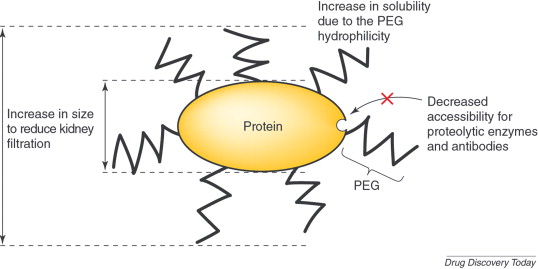Polyethylene glycol (PEG) is a polymer material widely used for the covalent modification of proteins and peptides. PEGylation is a drug technology that covalently binds PEG to a drug to improve its pharmacokinetic, pharmacodynamic, and immunological properties, enhancing its therapeutic effect. PEG has become one of the most commonly used polymer materials because of its non-toxic, non-immunogenic, non-antigenic, and good water solubility. PEG can change the physicochemical properties of the drug, which leads to the improvement of the retention time of the drug in the body and the prolongation of the half-life. In addition, PEG will also affect the binding affinity of the drug to the cell receptor and improve tumor targeting. The impact of PEG on drugs is more than that. After PEG modifies the drug, it can reduce the number of administrations, improve the efficacy, improve the tolerance, and reduce the severity and the incidence of adverse events. At the same time, PEG can also increase the solubility and stability of proteins, which is also beneficial to the production and storage of drugs. Therefore, PEG is often used as a drug delivery and modification technology, which can be directly coupled with drugs or attached to the drug surface and encapsulated in nanomaterials.
 Fig.1 Main advantages of PEGylated protein
Fig.1 Main advantages of PEGylated protein
PEGylated drugs generally include PEG, coupled drugs and linkers (Linker), and other parts. PEGylation is the optimization of drug solubility, immunogenicity, and biological function through various conjugated chemistries and linkers (shown in Fig.2). However, PEG also shows some defects in drug treatment. Researchers have found that long-term administration will lead to the accumulation of PEG in tissues, resulting in adverse reactions and tissue toxicity; the metabolism of PEG can also lead to the formation of acid metabolites which may cause side effects. In addition, it has been reported in the literature that long-term administration can also cause the production of PEG antibodies, reducing the therapeutic effect. Therefore, evaluating the safety and pharmacokinetic characteristics of improving PEG is essential. Recently, researchers have developed a non-immunogenic zwitterionic polymer as a material for drug therapy. The polymer has no toxicity, and long-term administration does not cause polymer accumulation and tissue lesions. The zwitterionic polymers exhibited significantly improved pharmacokinetic and immunological properties compared to conventional PEG. Therefore, this polymer has excellent potential for drug delivery.
 Fig.2 PEGylated drugs
Fig.2 PEGylated drugs
Profacgen is a state-of-the-art protein service provider. We provide custom protein services in the biological sciences, enabling access to the latest tools, techniques, and expertise with competitive pricing and rapid turnaround time. We serve a broad spectrum of industrial and academic clients committed to delivering high-quality data and customer services.
Please do not hesitate to contact us for more details if you are interested in this new method, and we will provide a considerate service for you. At the same time, we also offer other RNA-protein interaction detected services; please move to our website for more details.
References
Fill out this form and one of our experts will respond to you within one business day.